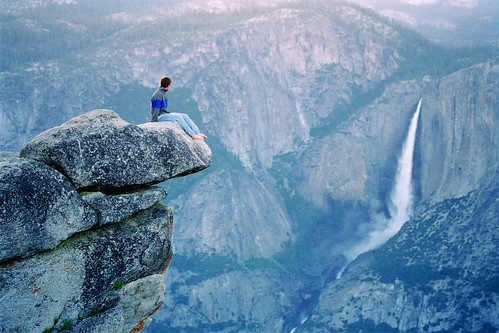
I finally got around to watching
An Inconvenient Truth on DVD the other night. Overall, I thought the movie was quite good - although I find Al Gore to be a trying representative for the issue (particularly as the face/voice who is used to personalize the issue), even while I recognize that as a political champion of climate change, he has done an outstanding and tireless job. I should also add that I think he is dead right on the issue, and represents the science, the politics, and the moral imperatives of the debate extremely well. That said, a few further comments on the film, and a few related articles that have recently caught my eye:
- I thought
An Inconvenient Truth conveyed various facets of the very complex and staggeringly large-scale issue of climate change extremely well. I was pleased at how well, in general, the film did in representing the science of climate change, including the core physics of how greenhouse gases work, the methods, data, and conclusions of long-term observation of key indicators of climate change (primarily temperature and atmospheric CO2 levels), and the relationship between human behavior and greenhouse gas emissions. Additionally, I thought the film struck the right balance between scientifically-grounded projection of the impacts of climate change and sensationalism when trying to illustrate what the consequences might be in human and visual terms (ice shelves dissipating, threats to polar wildlife, shifts in local weather patterns, increased frequency and intensity of catastrophic weather events, etc.).
- In framing the question of political will (particularly, in America), I thought the movie was effective at illustrating the human consequences of climate change, drawing analogies to Hurricane Katrina in New Orleans, presenting time-lapse projections of Lower Manhattan, invoking the impact on sub-Saharan Africa and tying in geo-political and humanitarian tragedies that will be second-order impacts, like Darfur. I also thought that the movie did a good job explaining the non-linear nature of climate change. The shift in understanding of the impact of climate change from higher temperatures, rising sea levels, and melting ice caps to increased incidence of catastrophic natural disasters, increased intensity of resource-driven human conflict, and the potential for massive human casualty is the only way to really drive home the moral dimensions of this issue that will confront us in the coming generations.
- Acknowledging the disproportionate impact that America, specifically, has in creating and failing to address climate change (thus far) was a necessary angle, and one the film did well. Calling out the lack of political will and the need for political and moral leadership on this issue may bask Al Gore in a kind light, but it is also absolutely necessary.
- By communicating the economic opportunity and loss of competitive and technology advantage created by the obstinacy of our political and business leaders on tackling energy efficiency as core priorities of economic policy and business innovation helps to frame the economic debate that is inextricable from climate change in the proper terms.
- I thought Al Gore did a particularly good job of aligning the political choice of taking meaningful action to address climate change, by individual Americans, as well as by America as a whole, with the legacy and self-image America has of making heroic political choices, from the founding of the nation, to the abolition of slavery, through the confrontations with fascism and totalitarianism in World War II and the Cold War. As a political narrative, I think this is the strongest positioning of the climate change issue that can be broadly understood and supported by the country, at large.
My few quibbles with the movie:
- While the movie represented the science of climate change well, it also managed simultaneously to undermine the seriousness of the analytics by presenting baffling and simplistic cartoons immediately after two of the more compelling scientific segments. I don't know if this was a direction necessitated by making the movie accessible to a young audience, but it struck me as doing a dis-service to the science in the rest of the movie.
- The closing credits of the movie highlighted choices and actions available to individuals to change their behavior to positively impact climate change, although they were strangely muted, both in the credits and on the movie's
website (which has a disappointing focus on self-promotion equal to
education and
advocacy...) What continually shocks me is how the movie, and Gore, while very clearly calling climate change a moral issue, refuse to focus the responsibility of every individual in contributing to this crisis, and the need for, yes, sacrifice. If people really believe that climate change will be a global crisis of the magnitude being described, than it is disappointing that so many advocates seem comfortable leaving their audiences with the impression that this is a crisis that can be addressed by changing your lightbulbs, weather-proofing your windows, and sending an email to your Senators and Representatives.
Tackling the question of material sacrifice, understanding that we may have to engage in less freedom to travel, to buy big houses and big cars, consume lots of things, is the hardest question in helping us to address our environmental problems. With the exception of a handful of people with a deep faith in technology innovation to address climate and sustainability issues, I don't know anybody who has thought deeply about these issues who believes that individual consumer behavior in America (now being replicated throughout the world, whenever economically possible) can continue on pace without increasing the stress on the Earth's environmental systems.
An Inconvenient Truth was a useful movie, but I remain skeptical that the necessary changes in behavior (and, consequently, political and market dynamics) can be invoked in America until a line connecting the human consequences of climate change to the fundamental lifestyle choices made by individuals. It's a difficult question, surely, but one that cannot be left by the wayside in an attempt to assure everybody that, although everything is not all right, everything will be all right.
A couple of recent articles related to climate change that bear comment:
-
Salon summarizes a spate of articles in the wake of the San Diego wildfires that try to use the fires as an illustration of the consequences of climate change, even though the ability to link such specific local tragedies to an issue like climate change is quite difficult:
Fire, flood, drought, hurricanes: In a world where climate change is predicted to usher in an era of extreme weather events, the temptation for impatient activists to treat each new unsettling outburst of Mother Nature as proof that the end is no longer nigh, but busting in the door, is irresistible.
For some crusaders, giving in to that sensationalist urge isn't just a guilty pleasure, but a strategic necessity, a way of evening up the rhetorical playing field. For example, writing in Grist, Glenn Hurowitz urges urges environmentalists not to be shy in exploiting the Southern California wildfires. The right wing, he notes, rarely demonstrates any compunctions about taking advantage of disaster to score political points. Case in point: JunkScience.com's Steven Milloy is already asserting that timber-management practices, i.e., restrictions on logging, are to blame for the loss of thousands of homes in Southern California.
A good idea, to seize upon this very emotional and current news item as a means for talking about a pressing, but long-term and abstract issue like climate change? I'm not sure, particularly given how important it is to establish beyond impeachment the scientific credentials of climate change within the political consciousness of the country, but we'll surely see if it works or backfires.
- An almost impossibly simplistic and mis-guided back-and-forth between
Steven Landsburg and
Joe Romm on the economic decision-making that might influence climate change policy on Slate.com. So many poor arguments, I'm not sure where to begin.
With Landsburg's original article, I actually agree with his premise and believe that it is important: a central question in how we view our options with respect to climate change is how much a person values their own right to certain material privileges versus the right of any other person (whether an abstract future person or an abstract person living in a 3rd world country right now) to life, health, a basic standard of living, and opportunity in life. It's often incredible to me how few people who study economics in the context of either environmental or social externalities understand this question. And Landsburg, having articulated the question, also clearly does not, either. His rhetorical framing of the trade-off occurring between you, now, and some stranger born 1000 years in the future fails to understand either the science or the moral dimensions of the climate change issue. His "modeling" of economic growth and the potential for "good" to come out of climate change demonstrates an understanding of economics that fails to leave the spreadsheet, dealing without insight into the uncertainty of economic growth (forget about growth necessarily bound to stability of ecological and economic conditions) or to the human consequence of massive upheavals and changes in the economy.
Romm, in his rebuttal, lands one great point, and then immediately undermines it. Romm is able to draw out the real concern of climate change - that it will have significant impact on human life and livelihoods within the span of one or two generations, and the uncertainty and magnitude of impact on human life is likely to escalate unless we can change the dynamics of our current carbon emissions patterns.. We probably aren't in a great position to change the immediate consequences, the damage is probably done. But without a very significant change in our carbon emissions and energy policy, we are likely to lose control of our ability to improve the chances of future generations to address and adapt to the consequences of climate change, as well as our own ability to manage the crises that will arise within the next fifty years. After making this point Romm inexplicably decides that the right way to frame climate change is by suggesting that we won't have to make changes to our lifestyles. Unfortunately, the equation here just doesn't map, unless you somehow believe that world population is going to magically stabilize, that new carbon-neutral technologies are going to materialize on large scales without a changed consumption pattern driving demand, and that the rest of the world is going to freeze their quality of lives at relatively lower level so we can preserve ours at a much higher level. Bullshit. I'm consistently confused whether this demonstrates a lack of understanding by the political leaders of this movement, or a calculation that the message of sacrifice won't sell, but unfortunately, without broaching that conversation, we don't change the political and economic dynamics necessary to face up to climate change.
If you recognize the magnitude and uncertainty of the human damage that a changing climate may create then you recognize the need to change fundamental behaviors in response.
















